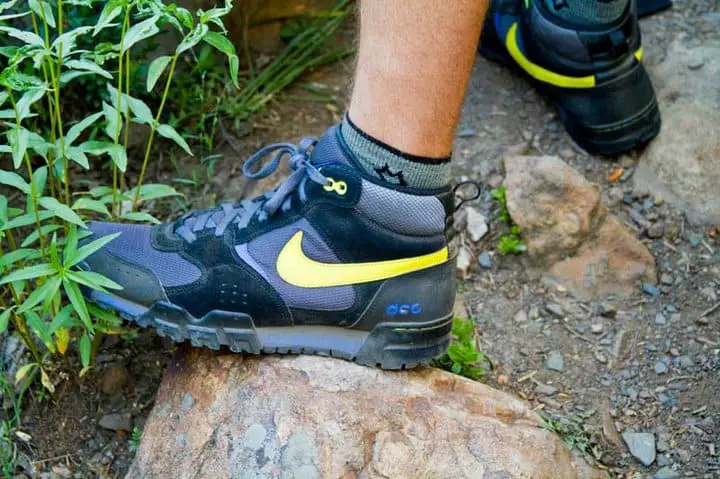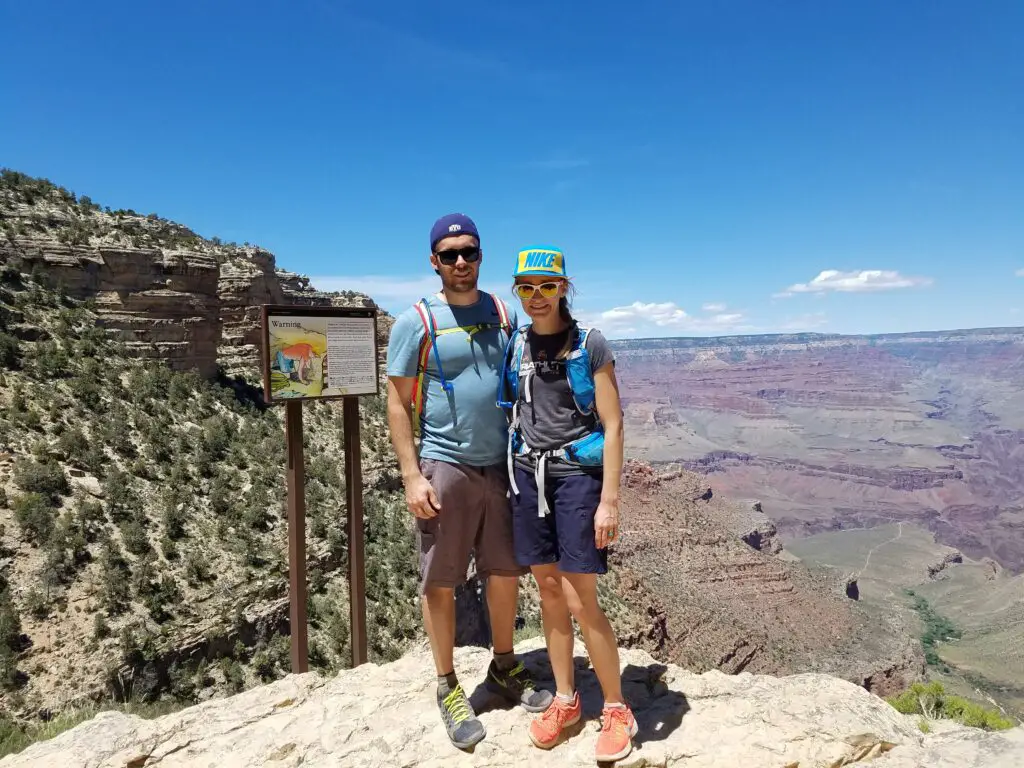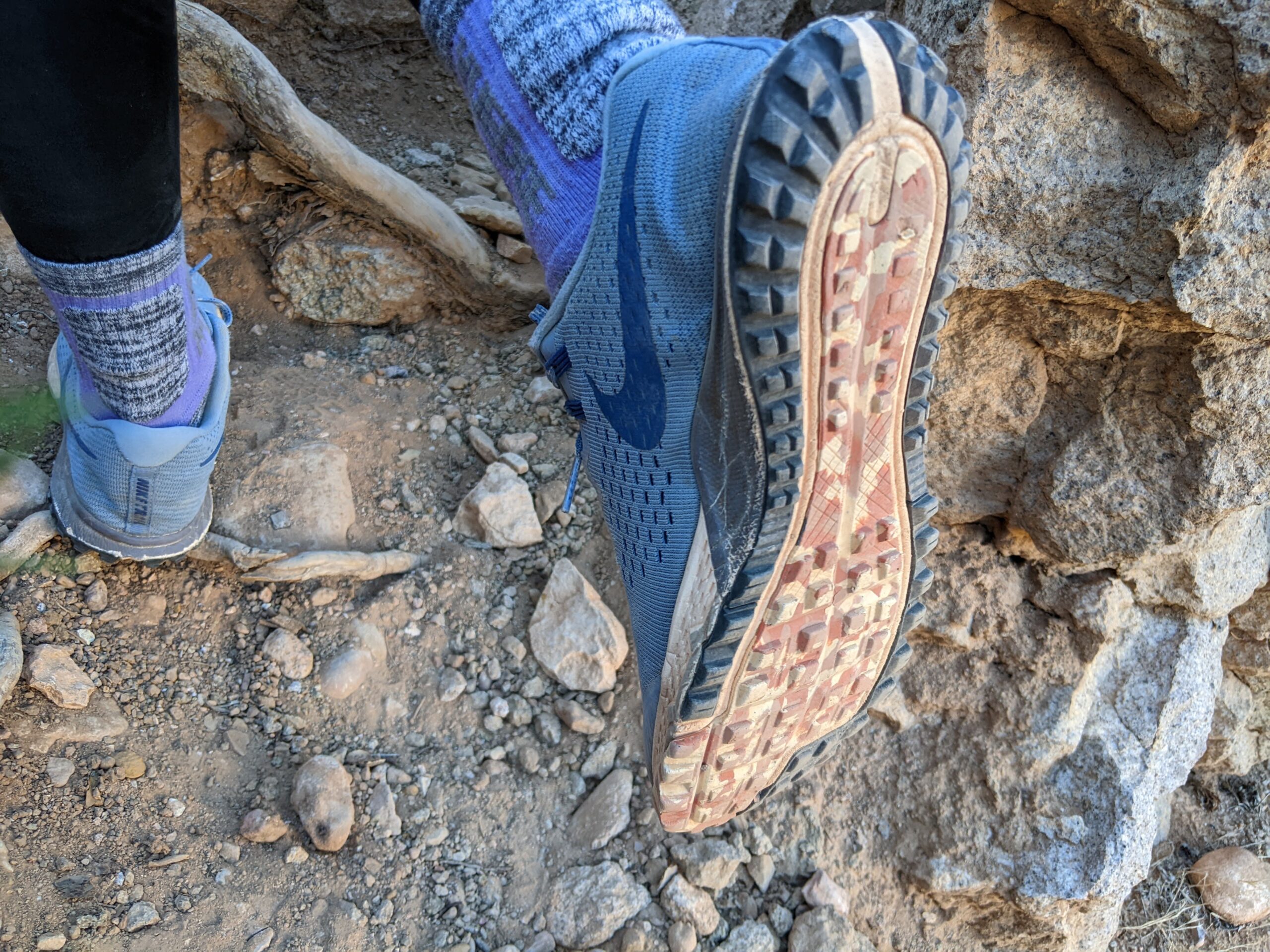If you hit any popular hiking trailhead throughout the US, or even the world, you’re guaranteed to see people hiking in Nike running shoes. They’re comfortable and breathe well, and are a pretty good option for simple and popular hikes.
Running shoes like those made by Nike can definitely be used for hiking, but there are a few drawbacks to be aware of. Running shoes are designed for pavement and asphalt and do not have traction designed to enhance traction in dirt. They also may not support hiker’s ankles as well over rough terrain, and can fall apart after taking some abuse hiking.
When you branch off of the main trails though or take the paths less traveled, you’re much less likely to see people in running shoes. More serious or more advanced hikers wear shoes and boots designed for hiking for a handful of reasons discussed below.
Using Nike Running Shoes as Hiking Shoes
The first thing I need to make clear is that not owning hiking shoes is absolutely NOT a reason not to go hiking. Nike Running shoes are perfectly adequate for the occasional hiker or for the person who sticks to well-traveled trails.
Running shoes do a good job of allowing your feet to breathe so they don’t get to sweaty, they flex and have soft soles that make your feet comfortable, and they’re readily available in any price range.
They’re perfectly adequate for hiking terrain, but are not ideal.
Why Nike Running Shoes aren’t the Best Option for Hiking
Traction
The top reason that running shoes like those made by Nike are not ideal for hiking is the lack of traction on dirt and rocky trails. Running shoes are almost always smooth along the bottom.
Shoes like the ever-popular Nike Free are incredibly lightweight and comfortable for running on roads, but taking them on a steep trail with loose gravel has them functioning like ice skates. The relatively flat soles have nothing to grab onto and slide backwards more easily than shoes with lugs on the soles.
Hiking shoes and boots have distinct tread with big rubber lugs or bumps that dig down through the top layer of loose dirt on the trail and grab hold of more firm terrain. This reduces the likelihood that hikers slip and fall, which reduces the likelihood of skinned knees, twisted ankles, or worse.
A specific type of hiking shoe- Approach shoes designed for climbing- has soles made of ultra-sticky rubber that works really well on rocks. They’re excellent for canyoneering or mountain biking where grippy soles are more important than big lugs that dig into dirt.
designed for climbing- has soles made of ultra-sticky rubber that works really well on rocks. They’re excellent for canyoneering or mountain biking where grippy soles are more important than big lugs that dig into dirt.
Durability
Running shoes just don’t stand up well to the rigors of hiking. This is especially important on hikes that traverse boulder fields or scree fields where there is a lot of loose rock.
Crossing an area like that or stepping between exposed roots can slice right through the thin sides of running shoes. Running shoes aren’t designed with any additional protection for your feet along the sides or top, which are areas that can take abuse while hiking.
All of the slipping and sliding around can also rip the sole off of a pair of running shoes, leaving you in a bad place if you’re in the middle of a long hike. Again, they’re designed to run and walk on flat surfaces, not to continuously bend and mold over rocks and roots.
Support
Coupled with the inferior traction, this is the area where hiking shoes are most important for preventing injury. Running shoes are often made from really thin materials that are marketed as things like, “flyweight,” “weave,” and “free.”
Those are great for when you want breatheability for your feet on a long run and the carry the least amount of weight possible; however, they just aren’t strong enough to support your feet and ankles while hiking.
Hiking shoes are much more rigid on the sides and top to help protect your feet from sliding rocks and sticks as well as thorns and other sharp objects. The toe box especially is usually pretty solid to protect your feet from stubbing your toes on unseen objects as you cross through rivers or through dense foliage.
Hiking boots offer full protection to your ankles, but even hiking shoes rise a little higher up than running shoes do in order to offer a little bit of extra support in that area. Twisted ankles are common on uneven terrain and can cause a big problem when they happen in the backcountry.

Waterproof
Nike running shoes are designed to be as thin as possible and definitely aren’t any sort of waterproof. Worse, the material can stretch if it gets really wet, which means any rigidity and support they offered while dry is gone.
Waterproof shoes help keep your feet dry from rain, morning dew on grasses and plants, snow, stream crossings, and marsh areas. Dry feet are happy feet, and they’re healthier feet as well.
Not all hiking shoes are waterproof, and depending on where you plan to hike, you may not need them to be. Waterproof shoes like those with Gore-Tex do not breathe as well, so they may not be ideal for desert climates.
Best Nike Shoes for Hiking
Nike does make a product line of outdoor shoes and apparel, called its ACG line. I’ve owned a couple of different pairs of Nike hiking shoes and boots, and have found them to be really nice.
They aren’t as durable as pure hiking shoes, but are really comfortable and have great traction. I definitely recommend checking out the Nike ACG Line to go along with the Adidas Terrex Line
to go along with the Adidas Terrex Line . These companies know how to make shoes, and have done a pretty good job in the outdoors space.
. These companies know how to make shoes, and have done a pretty good job in the outdoors space.
Trail Running Shoes as a Substitute for Hiking Shoes
Hiking shoes are going to be bulkier than running shoes, they’re going to be heavier than running shoes, and they won’t breathe as well as running shoes. Fortunately, many manufacturers have started making trail running shoes- an excellent mix between the two types of shoes that capitalizes on the strengths of both.
Many hikers, through hikers, and backpackers have switched over from bulky hiking boots to trail running shoes in order to save weight while still enjoying the features they need for rough terrain.
have switched over from bulky hiking boots to trail running shoes in order to save weight while still enjoying the features they need for rough terrain.
Trail Running Shoes offer the venting of running shoes that help your feet stay cool while running or hiking. They aren’t as lightweight as road running shoes, but are lighter than pure hiking shoes.
They have really good tread that grips deep into dirt or mud to ensure you don’t lose any ground while going up hill and don’t slip on the downhill portions. They’re a good cross between durability and flexibility.
Trail running shoes usually aren’t waterproof though, which is something to be aware of if you plan on going somewhere really wet. Traditional hiking boots may be better in those situations.

What about Hiking Socks?
Hiking socks are similar to hiking shoes in their necessity. They are a big help and are almost necessary for difficult hikes or backpacking trips, but if you’re just a casual hiker then it’s probably not necessary.
If you do choose to purchase a pair of hiking socks to go along with hiking shoes or even trail running shoes, they’ll do a good job helping to reduce the occurrence of blisters and hot spots. The merino wool material is unmatched in terms of temperature regulation and comfort as well.
I’ve written a lot more about the situations that hikers need hiking socks in my article, Why are Hiking Socks Important? 7 Features Regular Socks Can’t Provide .
.
Related Questions
Can Hiking Shoes be used for Walking? Hiking shoes work just fine for walking, but walking on cement and pavement will wear out the traction faster than walking on dirt and rocks. Walking and running shoes also weigh less than hiking shoes, so they may make you tire out a little bit more quickly.
See also: Why is Hiking So Tiring?
Can you Wear Hiking Shoes on Pavement? Hiking shoes work just fine on pavement, but they will wear out faster than if they’re primarily used on dirt and rocks. Hiking shoes have soles with lugs that provide traction on slippery surfaces, and pavement can wear them out prematurely.
Can Hiking Shoes be Used for Running? Traditional hiking shoes are too heavy to run long distances and are more rigid which makes them less comfortable. Trail running shoes are the perfect mix between hiking shoes and running shoes since they offer the tread of hiking shoes with the flexibility and venting of running shoes.

